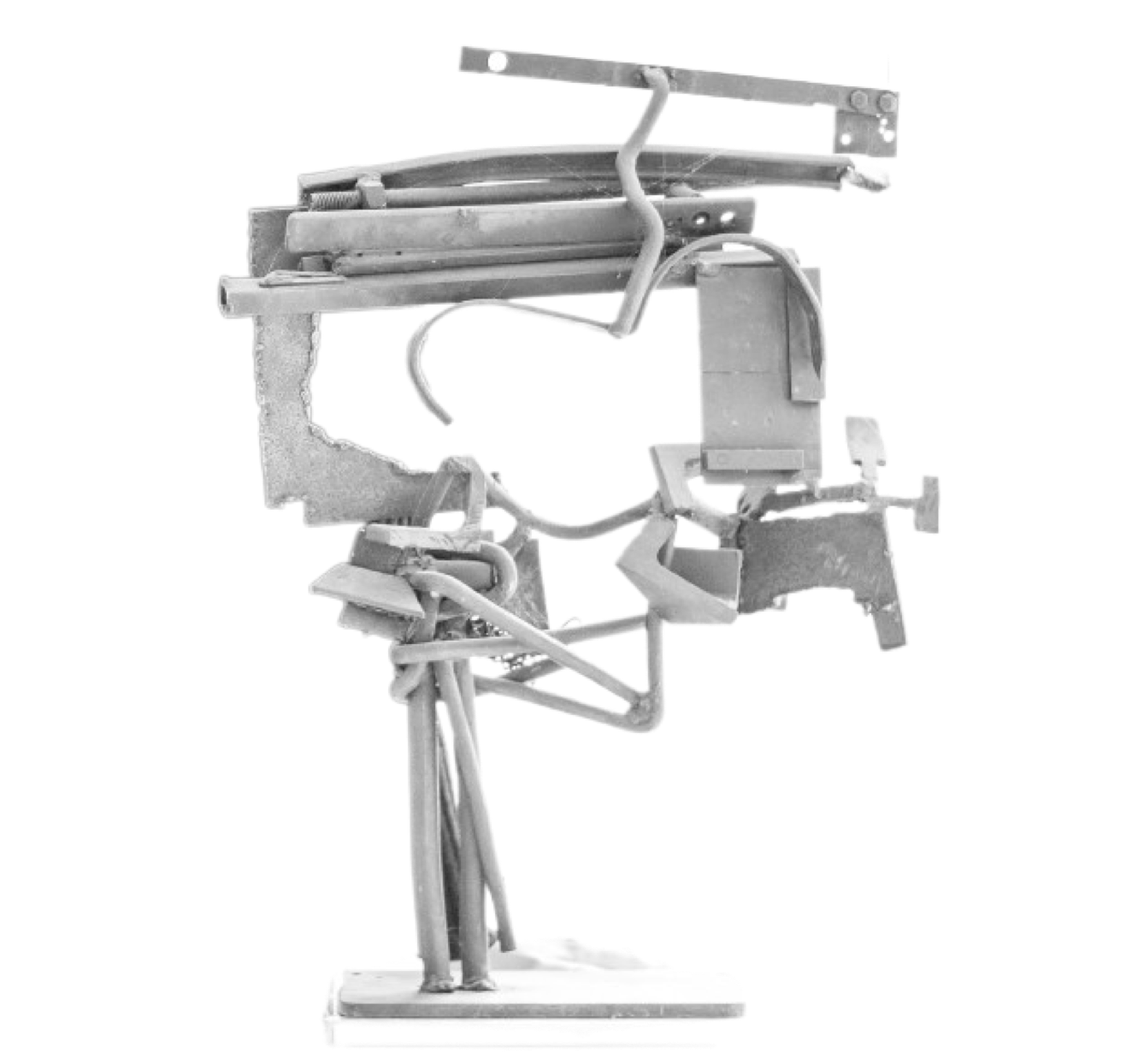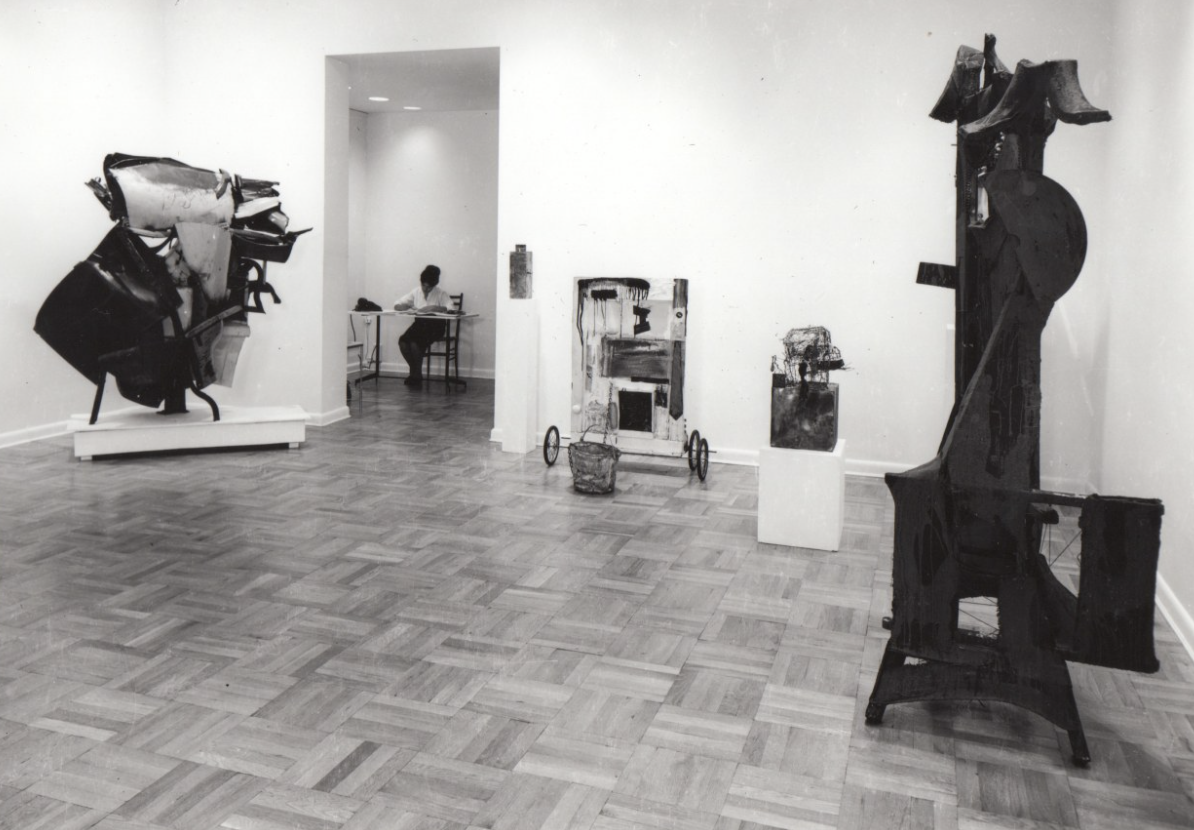1957 - 1959
John Chamberlain, Untitled, 1957
1957:
August 23-September 12: Chamberlain takes part in the inaugural group exhibition at the Wells Street Gallery in Chicago. This gallery was established by painters Robert Natkin, Judy Dolnick, and Stanley Sourelis, with inspiration from the annual Momentum exhibition. The gallery's focus is on abstraction. Gerald van de Wiele, who introduced Chamberlain to Black Mountain College, is also involved in this endeavor.
September 13-October 3: The Wells Street Gallery hosts Chamberlain's first solo exhibition. Chamberlain transports his welded steel sculptures from New York to Chicago in his car. These early sculptures show the influence of American abstract sculptor David Smith. Chamberlain uses scrap metal, often in rod form, to create spatial drawings.
Winter: Chamberlain establishes a studio in a former tobacco warehouse on Frankfort Street in Manhattan, near the Brooklyn Bridge. He maintains this space for about six months. During this time, Chamberlain spends his days making drawings with paint on paper and occasionally visiting the bar.
John Chamberlain, Stiele, ca.1957
1958:
April 9-May 5: Chamberlain's inaugural exhibition in New York is held at the Davida Gallery situated on lower Fifth Avenue. This show is a collaborative effort with Joseph Fiore, who also has ties to Black Mountain College. The opening attracts numerous artists from the Cedar Tavern, a well-known meeting place for artists during that period.
Chamberlain's presentation showcases a selection of welded steel sculptures, among them "Stiele" created around 1957. Remarkably, one of the exhibited works, "Stiele," captures the interest of Howard and Jean Lipman, who acquire it for their collection. This exhibition marks Chamberlain's introduction to the New York art scene, and his pieces gain acknowledgment and admiration within artistic circles.
May 12-31: Takes part in the "Three Men Drawings" exhibition hosted at the Hansa Gallery in New York. This collective exhibition involves Chamberlain alongside artists Robert Whitman and Lucas Samaras. The Hansa Gallery functions as an artist cooperative and is overseen by directors Richard Bellamy and Ivan Karp.
Chamberlain's involvement with the Hansa Gallery is a result of his increasing recognition within the artistic community. His artwork garners attention following its inclusion in a group exhibition at the March Gallery, another cooperative located on Tenth Street. This recognition leads to an invitation to showcase his work at the Hansa Gallery.
Of note, Chamberlain's association with the Hansa Gallery brings him into contact with Ivan Karp, a pivotal figure. Ivan Karp subsequently introduces Chamberlain to prominent gallerists Martha Jackson and Leo Castelli, both of whom play influential roles in Chamberlain's artistic journey.
During the summer, the Chamberlain family rents a residence owned by Larry Rivers in Southampton, New York. While staying there, Chamberlain stumbles upon a decaying 1929 Ford pie wagon on the property. Intrigued by this discovery, he removes the fenders, reshapes them by driving his own car over them, and then welds them together using the same steel rods he had used in his artworks. This creative endeavor results in the birth of his first sculpture that incorporates automobile metal, aptly named "Shortstop."
October 16: a significant event occurs in the Chamberlain family as their second son, Jesse Claude Chamberlain, is born.
November 3-22: Participates in the "Contemporary Americans" exhibition held at the Hansa Gallery in New York. This exhibition features his sculpture "Shortstop," crafted in 1958, marking his entry into integrating automobile metal into his artworks.
November 25-December 20: Three of Chamberlain's welded steel sculptures, namely "Ballantine," "Cord," and "Projectile D.S.N.Y," are showcased in an exhibition at the Martha Jackson Gallery in New York, further solidifying Chamberlain's presence in the art world.
Installation view, Work in Three Dimensions, at the Leo Castelli Gallery in New York
1959: In 1959, Chamberlain relocates his family to Camp Hill Road in Pomona, Rockland County, New York, while maintaining his studio loft on Broadway. He also starts working at Jerry's beauty shop in Rockland County. This job at the beauty shop is significant as it marks his final formal employment before being able to sustain himself through his artistic pursuits. This transition is facilitated in part by the support of collector and taxicab magnate Robert C. Scull.
January 2-23: Participates in an exhibition titled "The Enormous Room" at the Martha Jackson Gallery in New York. As part of this display, his artwork "Waumandie Gate" (1958), originally created for Martha Jackson's residence, is positioned at the entrance of the second-floor gallery. The space also features large-scale paintings by prominent Abstract Expressionists like Frita Bultman, Sam Francis, Michael Goldberg, and Alfred Leslie.
May 13-August 16: Chamberlain's early welded steel-rod sculpture titled "Rochester" (1958) is exhibited in the "Recent Sculpture USA" show at The Museum of Modern Art in New York. This marks a significant achievement as it represents Chamberlain's first artwork to be showcased in a museum exhibition. The exhibition subsequently travels to various venues, including the Denver Art Museum, Los Angeles County Museum of Art, City Art Museum of St. Louis, and Museum of Fine Arts, Boston.
October 20-November 7: Chamberlain takes part in the exhibition "Work in Three Dimensions" at the Leo Castelli Gallery in New York. The exhibition highlights his piece "Summer Sequence" from 1959.


